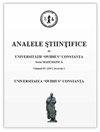Invariance property of a five matrix product involving two generalized inverses
IF 0.8
4区 数学
Q2 MATHEMATICS
Analele Stiintifice Ale Universitatii Ovidius Constanta-Seria Matematica
Pub Date : 2021-03-01
DOI:10.2478/auom-2021-0006
引用次数: 4
Abstract
Abstract Matrix expressions composed by generalized inverses can generally be written as f(A−1, A−2, . . ., A−k), where A1, A2, . . ., Ak are a family of given matrices of appropriate sizes, and (·)− denotes a generalized inverse of matrix. Once such an expression is given, people are primarily interested in its uniqueness (invariance property) with respect to the choice of the generalized inverses. As such an example, this article describes a general method for deriving necessary and sufficient conditions for the matrix equality A1A−2A3A−4A5 = A to always hold for all generalized inverses A−2 and A−4 of A2 and A4 through use of the block matrix representation method and the matrix rank method, and discusses some special cases of the equality for different choices of the five matrices.涉及两个广义逆的五矩阵乘积的不变性
由广义逆组成的矩阵表达式一般可以写成f(A−1,A−2,…,A−k),其中A1, A2,…,Ak是一个给定大小的矩阵族,(·)−表示矩阵的广义逆。一旦给出了这样的表达式,人们首先感兴趣的是它在选择广义逆时的唯一性(不变性)。以此为例,本文利用分块矩阵表示法和矩阵秩法,给出了矩阵等式A1A−2A3A−4A5 = a对A2和A4的所有广义逆a−2和a−4总是成立的充要条件的一般方法,并讨论了5个矩阵的不同选择下等式的一些特殊情况。
本文章由计算机程序翻译,如有差异,请以英文原文为准。
求助全文
约1分钟内获得全文
求助全文
来源期刊

Analele Stiintifice Ale Universitatii Ovidius Constanta-Seria Matematica
MATHEMATICS, APPLIED-MATHEMATICS
CiteScore
1.30
自引率
0.00%
发文量
15
审稿时长
6-12 weeks
期刊介绍:
This journal is founded by Mirela Stefanescu and Silviu Sburlan in 1993 and is devoted to pure and applied mathematics. Published by Faculty of Mathematics and Computer Science, Ovidius University, Constanta, Romania.
 求助内容:
求助内容: 应助结果提醒方式:
应助结果提醒方式:


